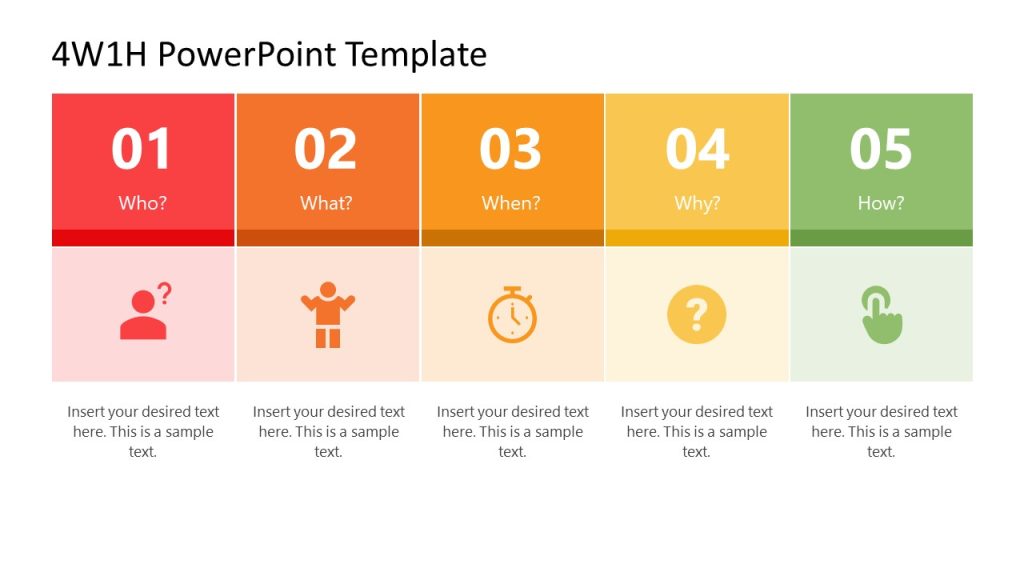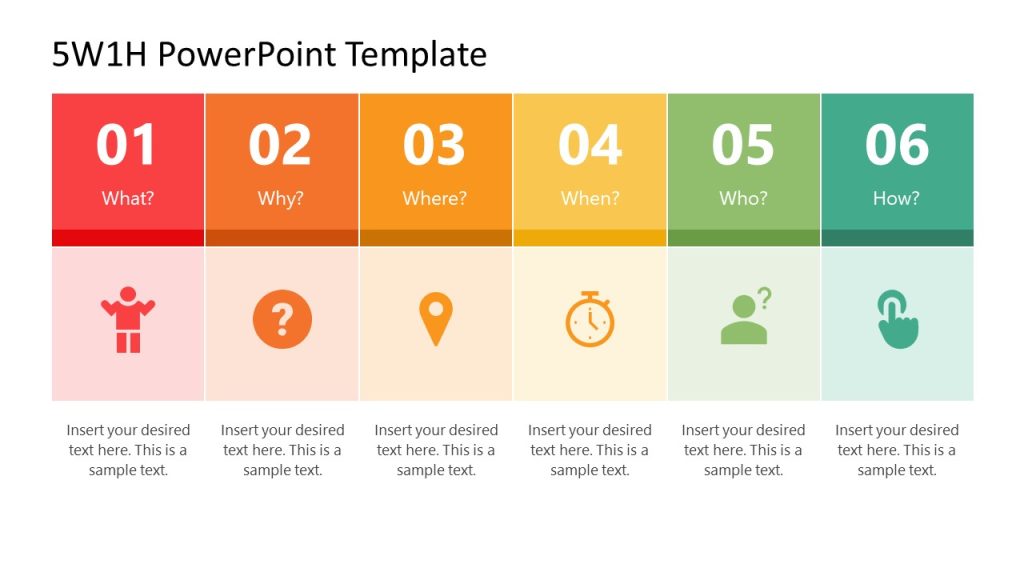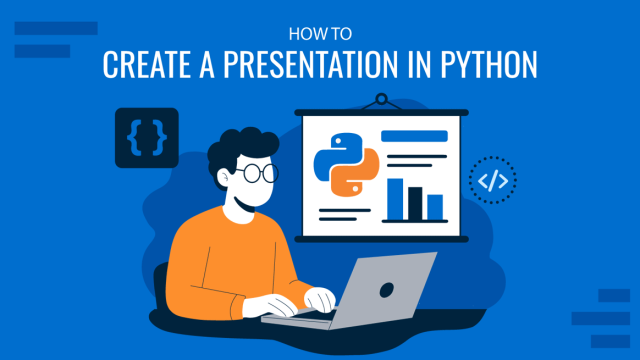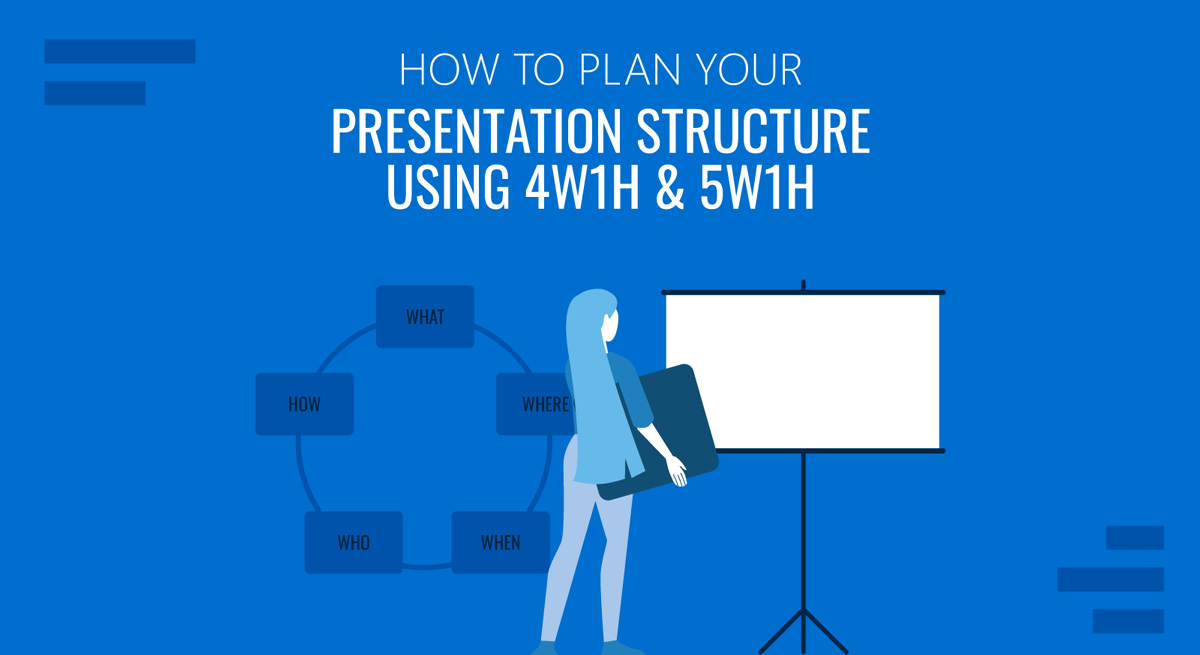
Planning the structure of a presentation is similar to creating a roadmap for meaningful communication. It is the organization of key points in a proper manner. This gives clarity to the audience and helps the speaker stay on track and focused. Tools like 4W1Hs and 5W1Hs make this process easier. By understanding the applications of their essential elements, speakers improve their presentations.
Table of Contents
- What is 4W1H & 5W1H?
- How to Integrate the 4W1H & 5W1H Framework into Presentation Planning
- How to Tailor the 4W1H & 5W1H Framework to Your Specific Presentation Goals
- How to Structure a Presentation Using 4W1H & 5W1H
- Common Mistakes to Avoid When Using 4W1H & 5W1H in Presentations
- Real-Life Applications of the 4W1H & 5W1H Framework in Presentation
- Combining 4W1H & 5W1H with Other Presentation Techniques
- Recommended PowerPoint & Google Slides Templates to Use the 4W1H/5W1H Framework
- Conclusion
- References
What is 4W1H & 5W1H?
The 4W1H covers What, Who, Where, When, and How, giving a whole structure for addressing any subject. However, the 5W1H extends it by adding “Why” to the framework. Thus, with this addition, the 5Ws can evaluate more in-depth information[6]. Therefore, these frameworks are powerful tools for extracting, organizing, and presenting crucial details.
4W1H
Who: It denotes an individual, group, or institution involved in an action.
What: It indicates people, things, or concepts changing due to an action.
When: It refers to the timeframe or schedule of an action. The notion of time would be days, weeks, or months. It also highlights observations before or after an action.
Where: This element points out the location or context. Locations are not just physical places but also abstract ones.
How: This element describes the way an action is carried out. It is the presentation of the method or process.
4W1H + Why = 5W1H

Why: It highlights the cause behind an action[1].
Historical Context and Evolution
The roots of 4W1H and 5W1H can be traced to ancient rhetorical practices in the Mediterranean region[3]. However, in 2010, it was found that Aristotle’s Nicomachean Ethics was the basis of 5W1H. It was used as a structure to assess a moral action[2]. The elements give a theoretical framework for interpreting an action and its circumstances. Over time, these frameworks evolved and used communication in various disciplines[4]. In the current era, they are used for problem-solving and information dissemination in multiple fields[4].
How to Integrate the 4W1H & 5W1H Framework into Presentation Planning
The presentation planning stage is the initial phase of making a presentation. This phase basically includes three to four steps to prepare for a presentation[5]. Using the Five Ws can greatly help in planning for a successful presentation.
Step 01. Audience Analysis
The first step of presentation planning is learning about the audience. The presenter must identify their audience’s demographics, including age, profession, and interests. It helps to understand what the audience might expect from the presentation[5]. Using 4W1H and 5W1H, analyze their expectations and what they hope to gain from your presentation.
The presenter should identify;
Who: Who is the target audience?
What: What are their interests and expectations?
Why: Why is understanding the audience crucial?
How: How will the presenter tailor the content to connect with them?

Step 02. Topic Selection
Topic selection usually depends on either the presenter’s or audience’s interests. If there is confusion about finalizing a topic, brainstorming with a few elements of the 5W1H questioning technique will help.
The presenter should know the following.
What: What topics align with the presenter’s expertise and audience interests?
Why: Why is it crucial to choose a relevant and engaging topic?
How: How will the chosen topic resonate with the audience?
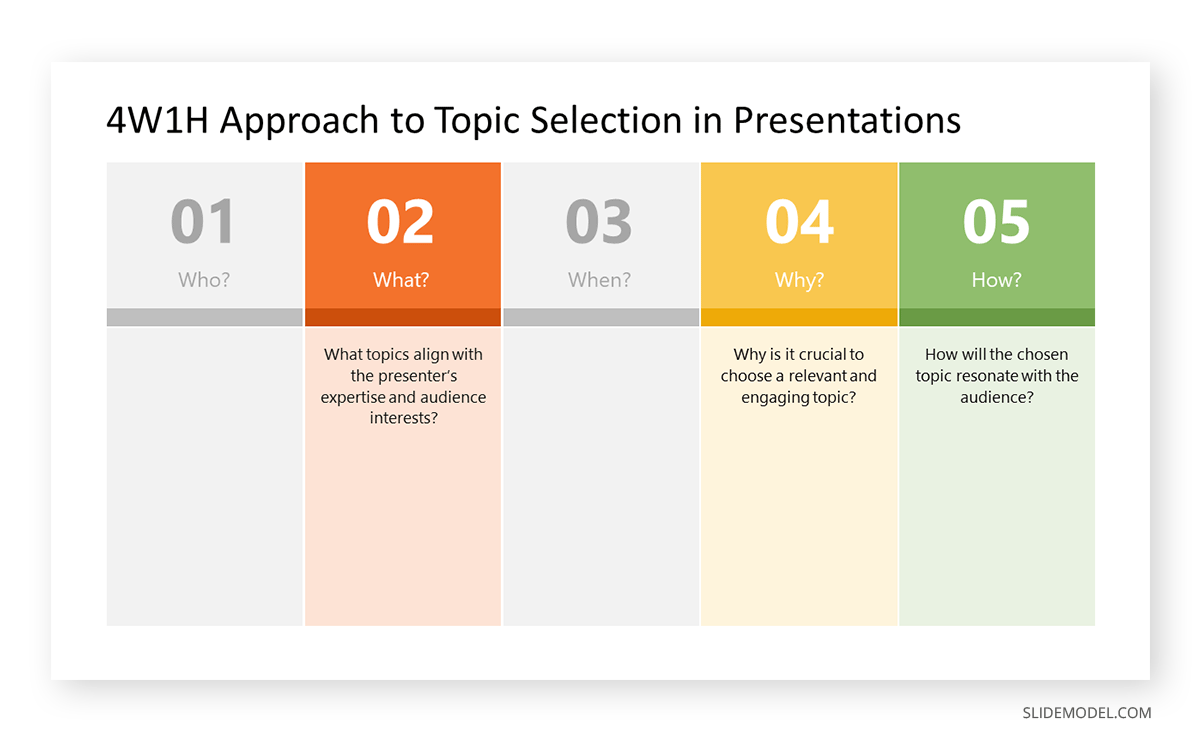
Step 03. Define the Objectives of the Presentation
Once a topic is selected, finalize the objectives of the presentation. The objective specifies what exactly an audience expects or learns from the presentation[5]. The presenter can clearly articulate what they want to achieve by the end of the presentation. The specific goals are outlined, whether to inform, persuade, or inspire[5]. Objectives should align with both the presenter’s goal and the audience’s expectations.
This can be done by asking;
What: What is the primary message I want the audience to take away from my presentation?
Why: Why is it crucial to clearly articulate the objectives of the presentation?
Where: Where can I incorporate the objectives to ensure they align with the presentation?
When: When will I evaluate whether the audience communicated and understood the objectives effectively?
Who: Who will benefit the most from the information or messages I plan to deliver?
How: How can the objectives cater to both the audience’s expectations and my own goals as a presenter?

Step 04. Gather Information
Now, the presenter has to gather the relevant information. The presenter will research thoroughly using reputable sources to collect the data. A balance of facts, statistics, and examples is a must to support the key message.
What: What specific data and examples support your key messages?
Where: Where is the information coming from?
When: When was the information published or last updated?
Who: Who is the information provider? An author, researcher, market analyst, or blogger?
How: How will you ensure the information is balanced and credible?

How to Tailor the 4W1H & 5W1H Framework to Your Specific Presentation Goals
While planning your presentation, you need to focus more on developing your specific presentation goal. The good thing about 4W1H & 5W1H is that these frameworks can help you define your specific presentation goal and improve your presentation skills.
Who
It is also important to acknowledge the specific audience for each goal, such as marketing team members, the board of directors, the project team, and executives. Their roles, interests, and level of expertise must be considered[7]. The presenter will modify the presentation content to match the audience’s expertise level. Using jargon that may be too advanced or too basic for their understanding should be avoided.
For instance, the goal is to inform about a product launch. The speaker will engage marketing team members and key stakeholders. He will also understand their familiarity with marketing strategies and industry trends.
What
It is about tailoring the content to each goal, including product launch details, budget increase justification, project milestones, and financial insights. It includes highlighting key project milestones that demonstrate progress and achievements.
When
It assists in scheduling presentations strategically, considering team meetings, board sessions, strategic planning, and dedicated training periods. It ensures that the information is disseminated efficiently and aligns with ongoing discussions. The presentation time is arranged based on the audience’s availability and engagement levels.
Where
This element will guide you in choosing an appropriate venue, like meeting rooms, boardrooms, and conference halls, to match the nature of each presentation. It is about considering the physical or virtual environment that best suits the content and interaction requirements.
Why
This element helps emphasize the importance of each goal, whether it is aligning the team, influencing decisions, inspiring motivation, or fostering skill development. It clearly articulates the purpose and significance of the presentation.
How
This element describes the methods, tools, and techniques used to convey information and engage the audience effectively. Presenters can use different methods, such as interactive elements, clear visuals, persuasive language, success stories, and Q&A sessions to achieve each specific presentation goal.
How to Structure a Presentation Using 4W1H & 5W1H
The structure of a presentation is divided into three parts, including an introduction, body, and conclusion[8]. However, using 5W1H can help arrange information in each part effectively.
Introduction
When starting your presentation, clearly state the objective or purpose of your presentation[8]. For that, you will use the “What” element to address the purpose.
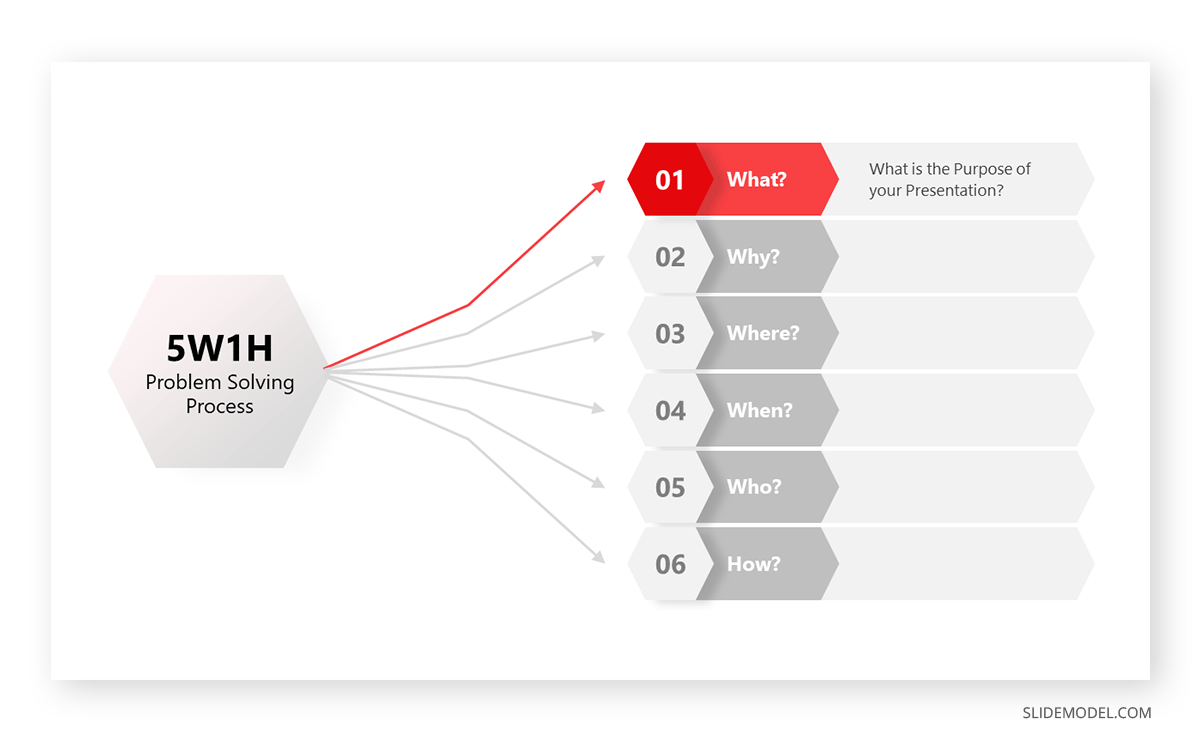
Body
What & Why: In the initial part of the present, you will elaborate on your objectives. Addressing the “What” and emphasizing the “Why” will support your main point.
Where & When: Adding more information, you will provide contextual details and timelines for key events or actions.
How: Meanwhile, in the body part, you will also discuss the methodologies, processes, or steps involved in achieving the presentation objective.
Who: In some presentations, you will also add the “Who” element in the body. Where you will define the key stakeholders, emphasizing their roles and involvement.
Use visuals such as charts, graphs, or diagrams corresponding to each W and H. Visual aids enhance clarity and engagement[9].
Conclusion
With the conclusion, you will end your presentation. You will revise the main points covered under each W and H, reinforcing the significance of your message.
Common Mistakes to Avoid When Using 4W1H & 5W1H in Presentations
Vague “Why” Statements
The audience may struggle to connect with the presentation when the “Why” aspect lacks specificity or is not articulated clearly. It causes disinterest and a lack of engagement. Presenters need to provide clear reasons to keep the audience invested.
Overloading Slides with Information (How, What)
Another common mistake is including too much data on slides without proper organization. It makes it difficult for the audience to focus on key points. Presenters should ensure each slide conveys a concise and impactful message.
Assuming Homogeneous Audiences (Who)
Treating the entire audience as a single, uniform group is problematic. It can result in a lack of resonance. Presenters should consider their audience segments’ varied interests, backgrounds, and needs while presenting the information.
Incomplete Information Gathering (What, Who)
Another mistake could be making assumptions about the answers without proper verification. Relying on incomplete or biased sources for information diminishes the presenter’s credibility. Failing to address one or more of the 5Ws also causes incomplete information. Thorough research using reliable sources is essential for a well-rounded and trustworthy presentation.
Ignoring Audience Feedback (How, Why)
Failing to address audience feedback limits the interactive nature of the presentation. Presenters should encourage questions and feedback. They can use feedback as an opportunity to enhance clarity and engagement.
Real-Life Applications of the 4W1H & 5W1H Framework in Presentation
In this section, we will present a series of examples of how to implement the 4WH1 & 5W1H Framework for specific presentation niches.
Application of the 4W1H & 5W1H Framework in Marketing Presentations
The marketing team is launching a new fitness tracker called “ActivePulse,” targeting health-conscious individuals. The team presents the product launch idea to key stakeholders, including investors, partners, and internal teams. They decide to use the 5W1H Framework to structure their presentation.
Introduction: What
Introducing ActivePulse
Description of ActivePulse as a fantastic fitness tracker.
Features highlighted: real-time heart rate monitoring, activity tracking, sleep analysis.
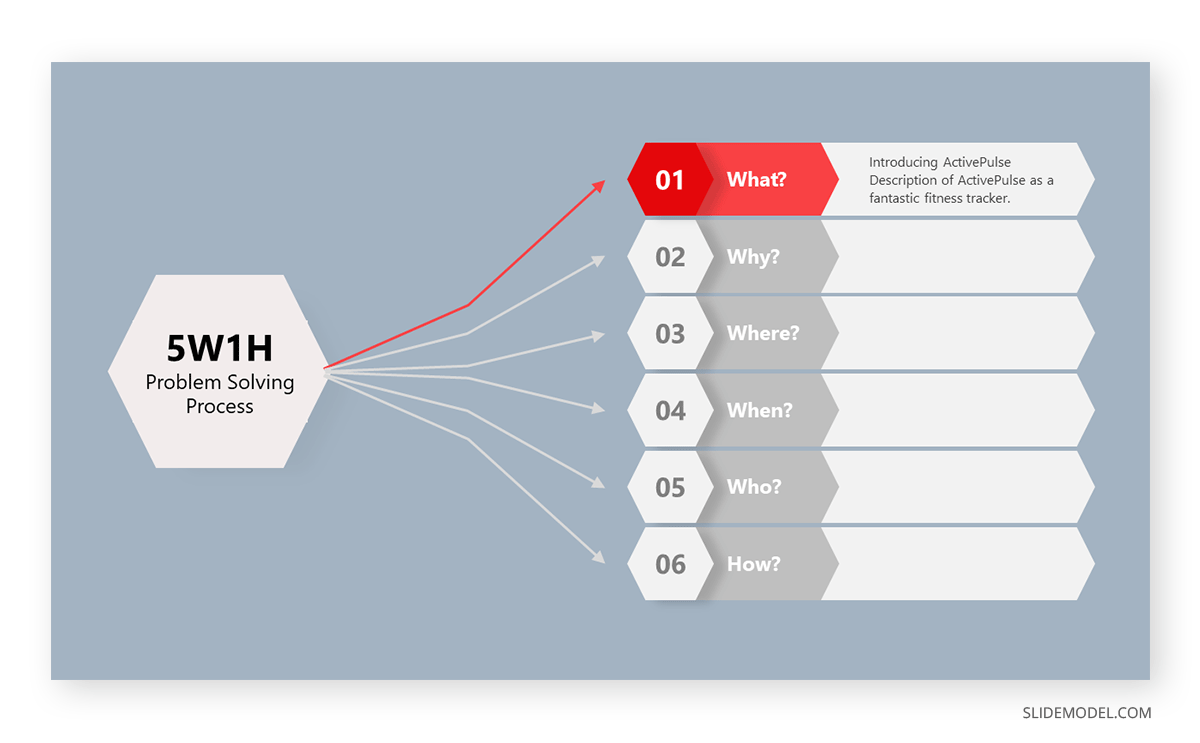
Why: Purpose and Unique Selling Propositions
Clear articulation of ActivePulse’s purpose: empowering individuals to lead healthier lives.
Identification of unique selling propositions: advanced health tracking, user-friendly design, and long battery life.

Where: Market and Distribution Channels
Analysis of the target market: health-conscious regions, fitness-focused demographics.
Overview of distribution channels: online platforms, retail partnerships, fitness centers.
Maps or graphics illustrating the reach of the product.
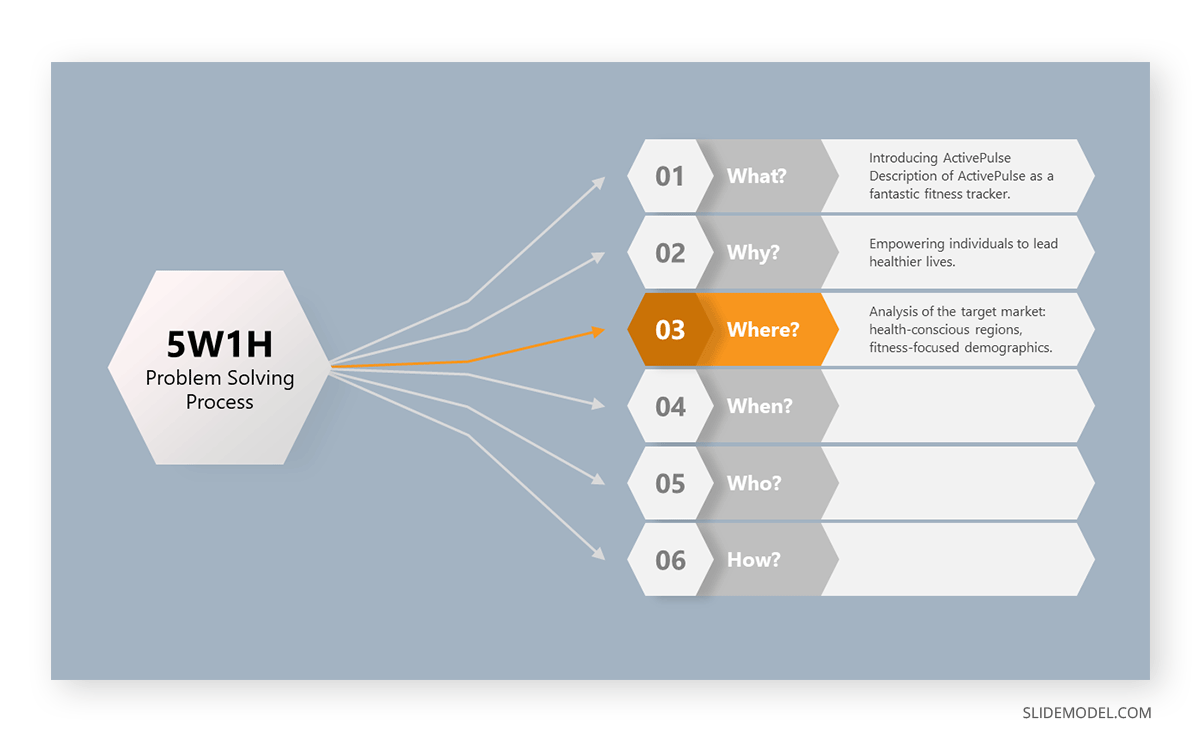
When: Strategic Timing
Discussion of the timing for marketing campaigns and product launches.
Consideration of fitness events, New Year resolutions, and seasonal trends.
A timeline illustrating the planned milestones leading up to the launch.
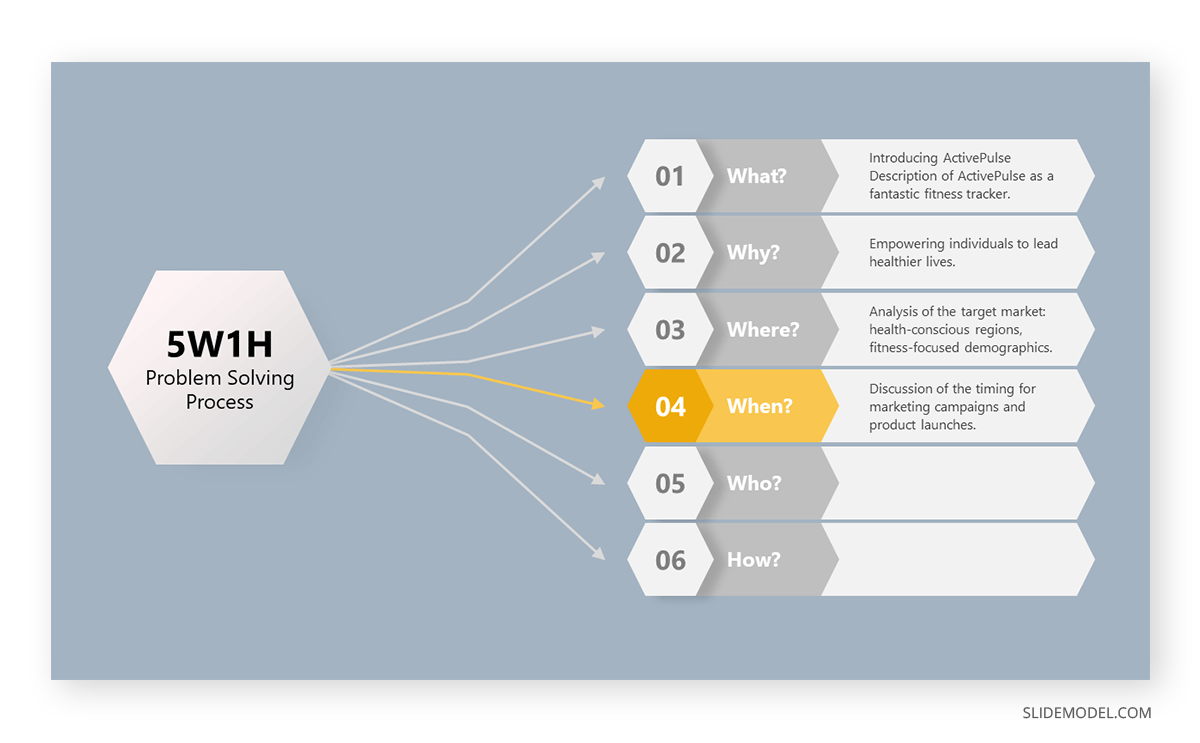
Who: Target Audience and Stakeholders
Definition of the target audience: health enthusiasts, fitness communities, tech-savvy individuals.
Identification of key stakeholders: investors, strategic partners, internal teams.
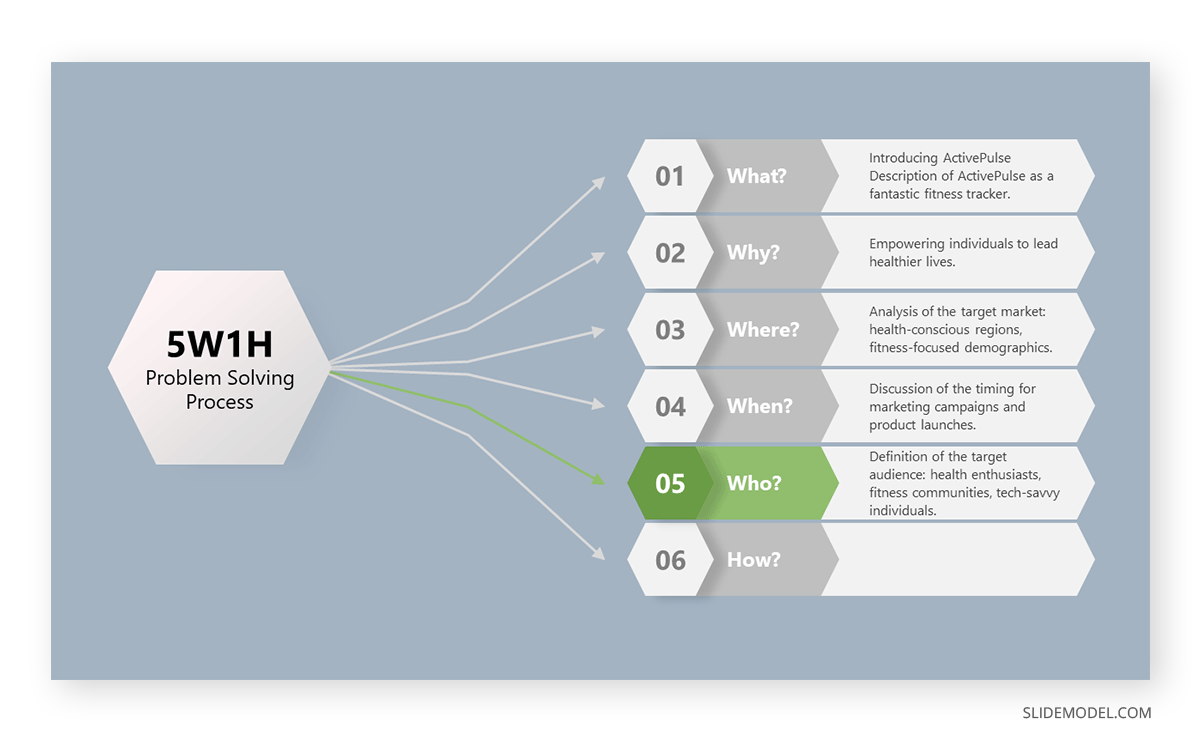
How: Advertising and Promotion Strategies
Outline of advertising channels: social media campaigns, fitness influencers, and tech publications.
Strategies for promotion: pre-launch discounts, influencer partnerships, and launch events.
Visual mock-ups of planned advertisements or promotional materials.
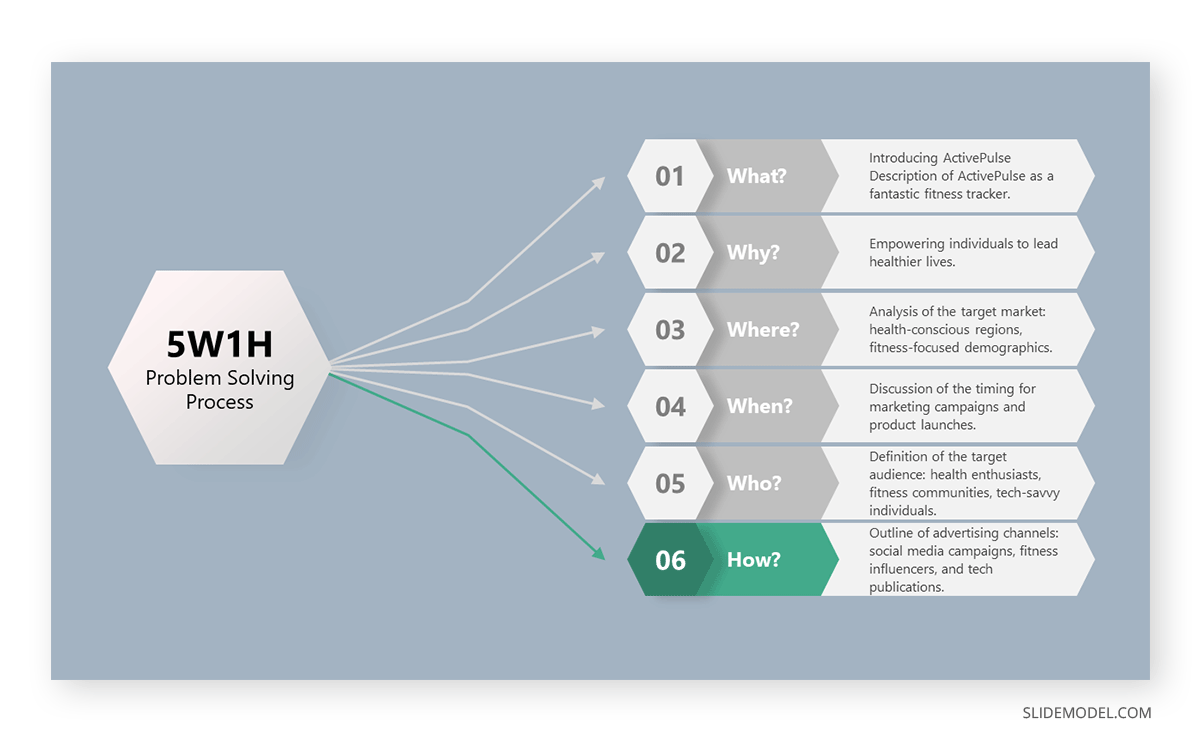
Application of the 4W1H & 5W1H Framework in Business Presentations
A company, TechEvolve, is undergoing a significant rebranding and restructuring initiative to enhance competitiveness in the tech industry. The leadership team presents the details of this transformation to key stakeholders, including employees, investors, and partners, and the brainstorming process that led to that presentation (the 5W1H framework).

What: Business Goals and Objectives
A clear outline of the business goals and objectives driving the restructuring.
Emphasis on increased market share, improved customer satisfaction, and technological leadership.
Who: Roles and Responsibilities
Definition of the roles and responsibilities of key personnel.
Where: Geographical Locations and Expansions
Identification of current geographical locations of operations.
Overview of planned expansions or strategic shifts.
Maps or graphics illustrating the global reach after restructuring.
When: Timelines for Project Implementations
Establishment of clear timelines for various project implementations.
Milestones for brand rollout, system upgrades, and operational changes.
A timeline graphic illustrating the phased approach to the restructuring.
How: Operational Processes and Methodologies
Development of operational processes, workflows, and methodologies.
Explanation of new technologies, tools, and workflows being introduced.
Why: Strategic Decisions and Changes
Detailed specification of the reasons behind strategic decisions or changes.
Clarification on market trends, competitive landscape, and the need for innovation.
Visuals illustrating market research insights and competitive analyses.
Extra Iteration – What: Q&A and Feedback
Encouragement for questions and feedback.
Contact information for further inquiries.
Application of the 4W1H & 5W1H Framework in Educational Presentations
A prestigious university, AcademiaX, is unveiling a new online course to expand its reach and provide high-quality education in the digital space. The university leadership plans to present the details of this innovative online course using Five Ws.
What: Introduction
Learning Objectives and Curriculum
Overview of the curriculum, highlighting key topics and modules.

Why: Significance and Goals
Explanation of the significance of introducing the online course.
Clear articulation of the goals.
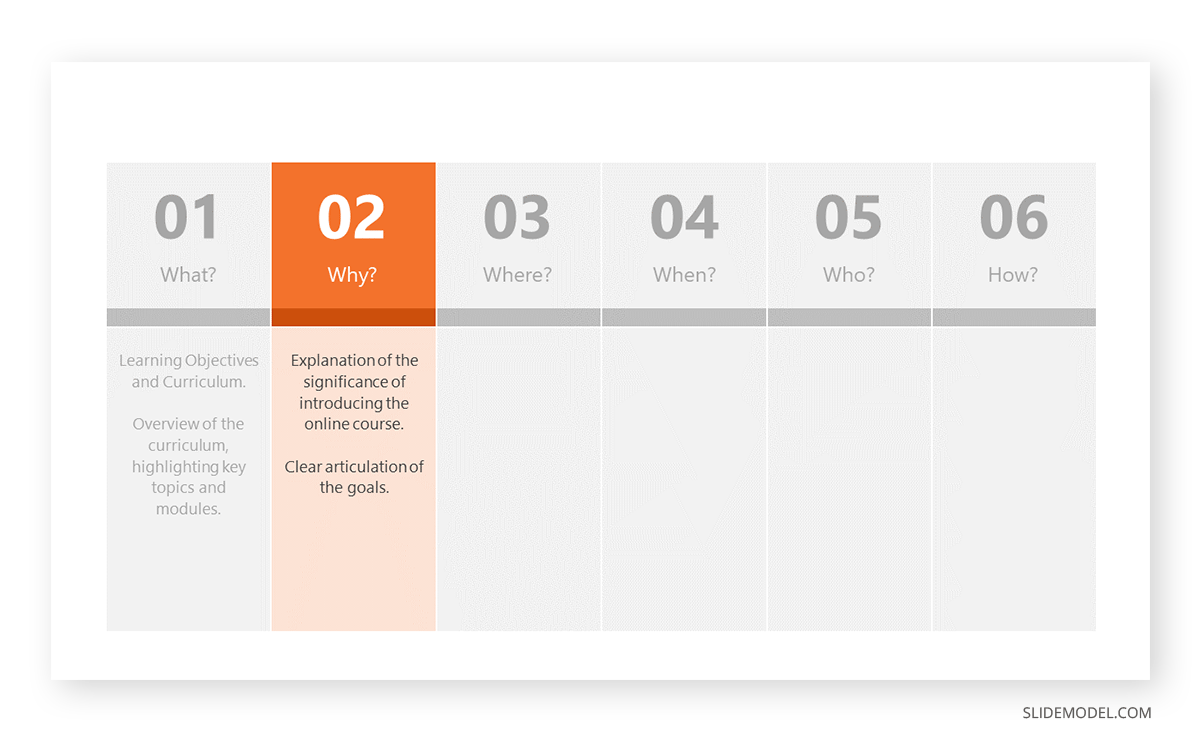
Where: Learning Delivery Locations and Platforms
Identification of the online platforms or learning management systems used.
Explanation of how the course caters to global learners.
Graphics representing the accessibility and reach of the online course.
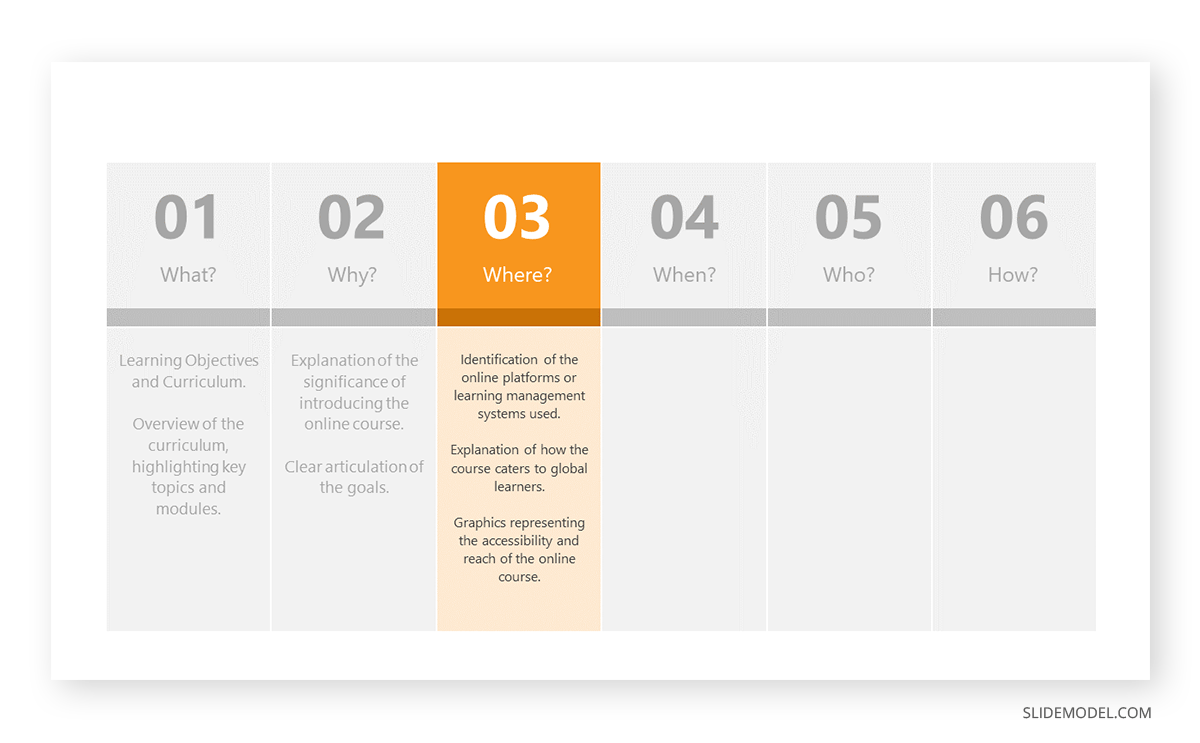
When: Schedule and Duration
Establishment of the course schedule, including start dates and session durations.
Overview of any flexible learning options or self-paced modules.
A timeline graphic illustrating key milestones and sessions.
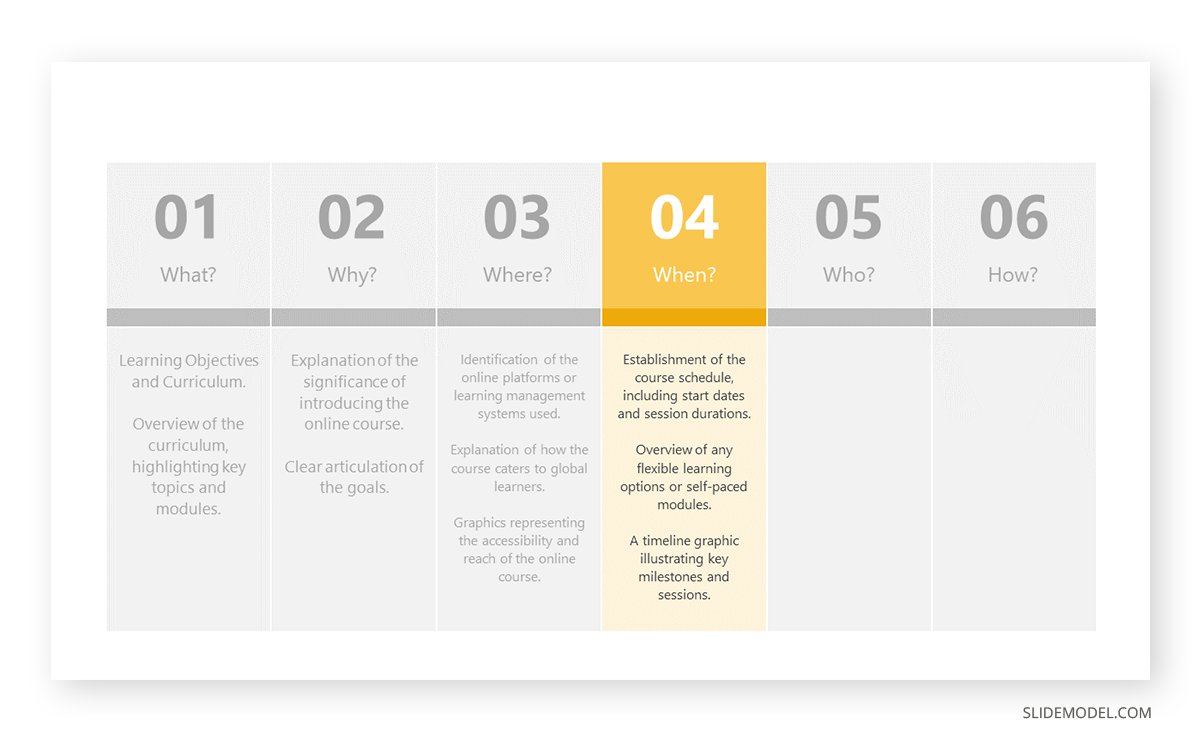
Who: Target Audience and Educators
Specification of the target audience: professionals seeking further education, remote learners, etc.
Introduction of the esteemed educators and faculty involved in the online course.

How: Teaching Methods, Materials, and Assessments
Detailed explanation of the teaching methods employed, such as live lectures, discussion forums, and multimedia content.
Showcase learning materials, including e-books, videos, and interactive tools.
Overview of assessments, quizzes, and projects to gauge student understanding.
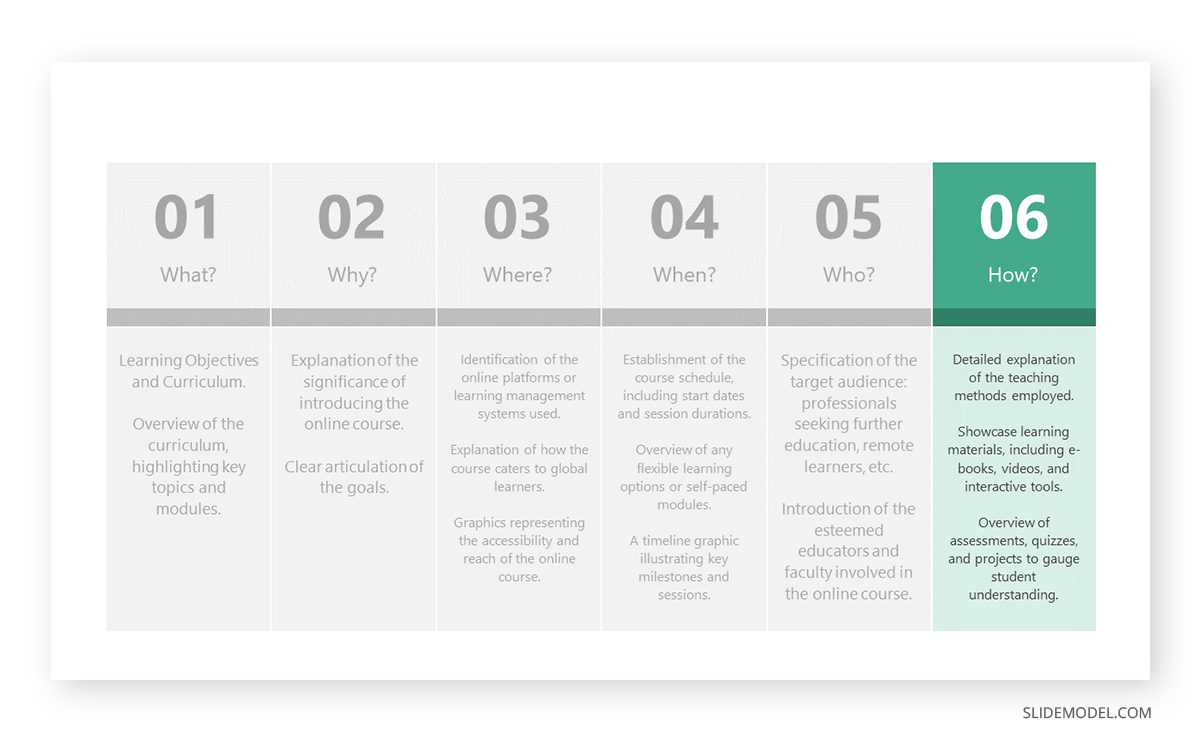
Conclusion
Recap of key points from the presentation.
A call-to-action, such as registering for the course or spreading the word.
Executive-Level Presentations: Adapting the 5W1H Framework for Executives
In this executive briefing, the presenter presents a strategic vision for organizational growth and market expansion, using the 5W1H.
What: (Intro & Strategic Objectives)
It briefly overviews the presentation’s purpose.
Statement about the importance of strategic objectives for organizational success.
The presenter defines the organization’s strategic goals, outlining key performance indicators.
Who: Identifying Key Partners
Identify key industry leaders, potential collaborators, and regulatory bodies.
Where & When: Geographical Expansion
It discusses geographical expansions and market-entry timelines.
The presenter will focus on high-level strategies, focusing on innovative approaches and partnerships.
Timeline indicating market-entry plans.
Why: Emphasizing Market Impact
Clearly articulate the impact of your strategies on key business metrics such as market share, profitability, and long-term sustainability. Use infographics to visually communicate positive outcomes, making it easy for executives to grasp the benefits of your initiatives.
How: High-Level Strategies
Outline the innovative approaches and strategic partnerships that will drive your market expansion. Use visuals such as icons or illustrations to represent these strategies.
Combining 4W1H & 5W1H with Other Presentation Techniques
Applying 4W1H & 5W1H in Six Sigma Implementation
The implementation becomes more structured by incorporating 4W1H and 5W1H at each stage of the Six Sigma methodology. It will address key aspects essential for successful process improvement.
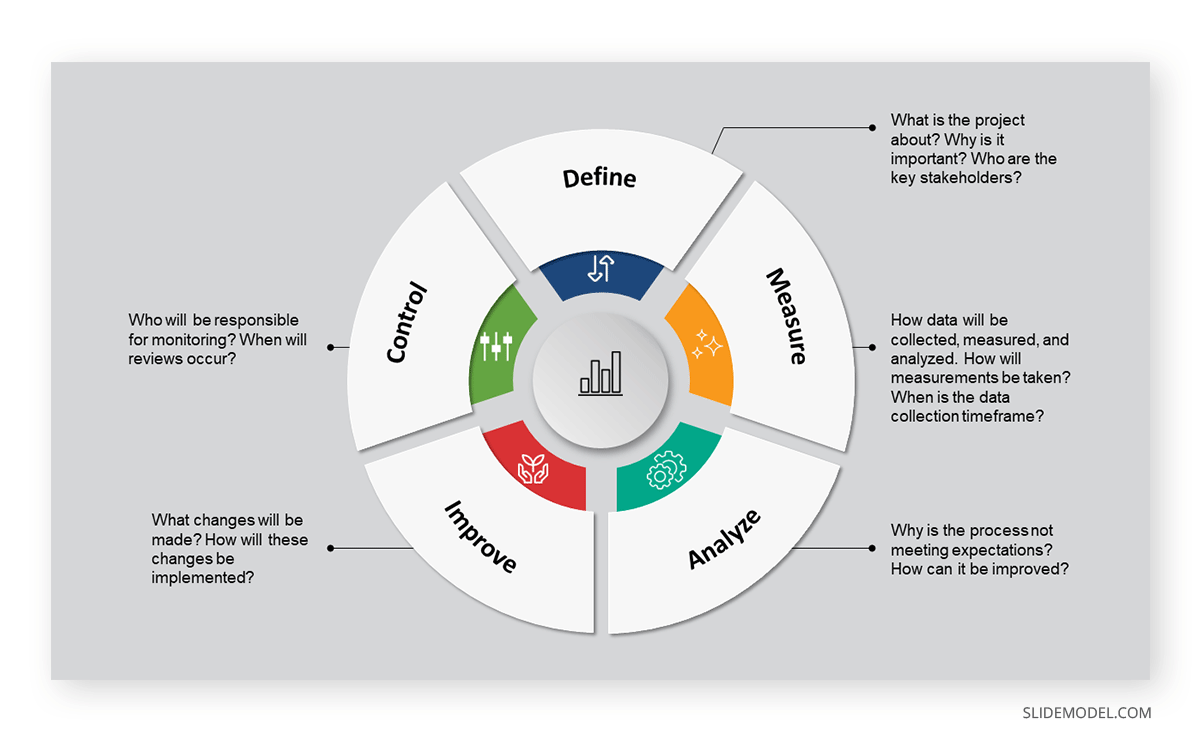
Define (What):
Clearly define the project scope, objectives, and customer requirements. What is the project about? Why is it important? Who are the key stakeholders?
Measure (How & When):
Determine how data will be collected, measured, and analyzed. How will measurements be taken? When is the data collection timeframe?
Analyze (Why & How):
Understand why variations occur and how they impact the process. Why is the process not meeting expectations? How can it be improved?
Improve (What & How):
Develop and implement solutions to address identified issues. What changes will be made? How will these changes be implemented?
Control (Who & When):
Establish control measures and protocols to sustain improvements. Who will be responsible for monitoring? When will reviews occur?
Applying 4W1H & 5W1H with Pyramid Principle in Presentation
The Pyramid Principle is a communication technique that advocates for hierarchically organizing information. It gradually expands to supporting details, starting with the most critical points at the top.
Pyramid Principle Structure
What: Organize the main message at the top of the pyramid.
Who, Why, Where & When, How: Ensure the interconnectedness of these elements, placing “Who” at the pinnacle and influencing the understanding of all other aspects.
Prioritize Information (All Ws & H)
Who: Prioritize information focusing on key stakeholders.
What: Outline the main message or central theme.
Where & When: Address the context and timing of the presentation.
How: Introduce the approach or methodology.
Why: Emphasize the importance of the message.
Supporting Points Below
What: Present supporting points contributing to the main message.
How: Elaborate on the methodology or approach.
Where & When: Provide additional context or timing details.
Further Details and Examples
What & How: Expand with specific information and examples reinforcing the main message and methodology.
Why: Reiterate the importance of the message.
Applying 4W1H & 5W1H in Problem-Solution Format
Let’s apply the 4W1H and 5W1H frameworks within the context of a problem-solution presentation. Assume the problem is a decline in employee engagement within a company, and the goal is to present a solution to improve overall employee satisfaction and motivation.
Problem
- What: Decline in Employee Engagement
- Why: Low morale, lack of motivation, and decreased productivity
- Who: All employees across different departments and levels
- When: Ongoing issue affecting daily operations
- Where: Company-wide, impacting various workspaces and teams
- How: Identified through surveys, feedback sessions, and performance indicators
Solution Presentation
- Introduction (Why): Clearly articulate the importance of addressing the decline in employee engagement.
- Explain how low morale and motivation can impact productivity, innovation, and overall company success.
- Use storytelling to share anecdotes or data highlighting the current situation’s negative consequences.
- Current State Analysis (What & How): Use visual aids like charts or graphs to depict key metrics like satisfaction scores, retention rates, and productivity levels.
- Discuss the methods employed to assess the current state, including surveys, focus groups, and performance metrics.
- Identifying the Audience (Who): Tailor the presentation content to different audience segments, including executives, managers, and front-line employees.
- Address each group’s specific concerns and interests, emphasizing how the solution benefits them directly.
- Proposed Solution (What & How): Present the proposed solution to improve employee engagement, including initiatives such as mentorship programs, wellness initiatives, and flexible work arrangements.
- Detail the specific steps and actions that will be taken to implement the solution.
- Use the Minto Pyramid Principle to structure the information, placing the most critical elements at the top for clarity.
- Implementation Timeline (When & How): Outline a detailed timeline for implementing the proposed solution.
- Highlight key milestones and iterations, applying agile principles to showcase adaptability and responsiveness to feedback.
- Schedule regular check-ins or progress updates to inform the audience about the implementation process.
- Communication Channels (Where & How): Specify the communication channels that will be used to disseminate information about the solution.
- Consider both physical and virtual environments, using appropriate venues for team meetings, town halls, and online platforms for remote or dispersed teams.
- Benefits and Outcomes (Why): Emphasize the positive outcomes of implementing the solution, such as increased employee satisfaction, improved teamwork, and higher productivity.
- Connect these benefits to the overall success of the company and its strategic objectives, aligning the solution with the broader organizational goals.
- Feedback Mechanism (How & When): Establish a feedback mechanism to gather employee input throughout the implementation process.
- Use audience engagement techniques like surveys or interactive sessions to encourage ongoing communication and collaboration.
- Training and Support (How): Describe the training programs and support mechanisms that will be in place to help employees adapt to the changes.
- Incorporate hands-on training sessions, workshops, or resources to ensure a smooth transition.
- Conclusion (Why & How): Summarize the key points, reiterating the importance of addressing the employee engagement issue.
- Conclude with a persuasive call-to-action, inspiring the audience to support and actively participate in the solution implementation.
Training and Development Sessions: Adapting the 5W1H Framework for HR and Training Managers
In tailoring the presentation for HR and Training Managers, the 5W1H framework serves as a guiding principle. The focus is on enhancing employee development and aligning with new HR policies. The presenter defines clear training objectives, identifies target employee groups, and presents a well-structured schedule.
What
Define the employee development program’s objectives and training content.
Showcase new HR policies and procedures relevant to training initiatives.
Who
Identify target employee groups for training, considering different departments and job roles.
Highlight key stakeholders involved in the implementation of HR policies.
When
Present a training schedule, considering team meetings, onboarding sessions, and ongoing development opportunities.
Discuss the timing of policy rollouts and training sessions to align with organizational needs.
Where
Choose appropriate training venues, including physical spaces for on-site sessions and virtual platforms for remote teams.
Consider the accessibility and comfort of the training environment for effective learning.
Why
Emphasize the importance of employee development in enhancing skills and job satisfaction.
Communicate the rationale behind new HR policies, linking them to positively impacting workplace culture and employee engagement.
How
Illustrate the training methodologies, incorporating interactive elements, workshops, and e-learning modules.
Demonstrate the tools and resources available to support HR policies and facilitate effective training.
Recommended PowerPoint & Google Slides Templates to Use the 4W1H/5W1H Framework
Conclusion
Structuring a presentation is crucial for effective communication, and the 5Ws offer a simple yet powerful framework. This approach ensures the presenter addresses the fundamental questions, producing a well-organized message. By following this structure, presenters can deliver information in a logical sequence. The 5Ws act as a guide, helping to maintain relevance, completeness, and clarity throughout the presentation.
If you need a quick method to create a presentation, check out our AI presentation maker. A tool in which you add the topic, curate the outline, select a design, and let AI do the work for you.
References
[1] Chakma, K., Das, A. and Debbarma, S., 2019. Deep semantic role labeling for tweets using 5W1H: Who, What, When, Where, Why and How. Computación y Sistemas, 23(3), pp.751-763. https://www.scielo.org.mx/scielo.php?pid=S1405-55462019000300751&script=sci_arttext&tlng=en
[2] Sloan, M.C., 2010. Aristotle’s nicomachean ethics as the original locus for the septem circumstantiae. Classical Philology, 105(3), pp.236-251. http://www.jstor.org/stable/10.1086/656196 .
[3] Bešker, I., 2022. „The Roots of the 5 Ws “. Dostupno na: https://hrcak. srce. hr/file/61689, datum pristupa, 5.
[4] Fauziah, Y., Putri, E.Y., Susmita, A. and Purba, H.H. 2021, A Systematic Literature Review Of 5w1h In Manufacturing And Services Industries. 3rd Mercu Buana Conference on Industrial Engineering-MBCIE 2021.
[5] Steps in Preparing a Presentation. Online learning tutorials for essential college skills. Available at: https://pennstatelearning.psu.edu/istudy_tutorials/oralpresentations/oralpresentations3.html
[6] Using the 5Ws to Evaluate Information. https://crc.losrios.edu/crc/main/doc/services/library/5ws-evaluation-worksheet.pdf
[7] Understanding Your Audience. Fundamentals Of Engineering Technical Communications. https://ohiostate.pressbooks.pub/feptechcomm/chapter/2-audience/
[8] Structuring your presentation (2023) Australian National University. https://www.anu.edu.au/students/academic-skills/writing-assessment/presentations/structuring-your-presentation#:~:text=Just%20like%20other%20forms%20of,the%20significance%20of%20your%20talk
[9] Designing Effective Presentation Materials. Effective Presentation Skills Tutorial. https://www.niu.edu/presentations/design/index.shtml
